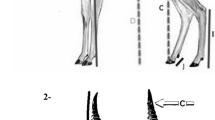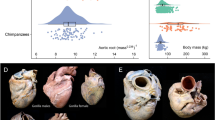Abstract
IN the study of relative growth of organs and tissues, there are certain advantages in referring the relative weights to age, throughout the life-cycle. When results are expressed according to the allometric formula1–3, y = bx α (x = weight of animal, y = weight of organ, b and α=constants), time as an independent variable tends to be eliminated. When, however, the relative weights are expressed in relation to age or its logarithm, they are found to show maximal values at definite periods of the life-cycle, specific for and characteristic of each organ4. The curves of the relative weights, as functions of the logarithm of age, tend to follow one of the types in Fig. 1. Thus, in the rabbit, that of the brain follows, from the nineteenth day of embryonic life until adult age, curve 1 of Fig. 1, that of the liver and of the lungs, curve 2, with maximal values respectively at the twenty-fourth and at the twenty-seventh day of embryonic life; that of the kidneys, curve 3, with a maximum between the second and fourth weeks after birth; that of the stomach, curve 4, with a maximum between the fifth and tenth weeks; that of the muscles, curve 5, with a maximum after puberty; and that of the perirenal adipose tissue seems to follow curve 6 with maximal values only late in the adult age. The same sequence of organs, ranged according to periods of maximal relative weights, is likely to be found in other mammals, as is seen from observations of C. M. Jackson5 on human brain, liver, lungs and kidneys the relative weights of which are maximal in the second, at the end of the third, in the fourth and between the seventh and eighth months respectively.
This is a preview of subscription content, access via your institution
Access options
Subscribe to this journal
Receive 51 print issues and online access
$199.00 per year
only $3.90 per issue
Buy this article
- Purchase on Springer Link
- Instant access to full article PDF
Prices may be subject to local taxes which are calculated during checkout
Similar content being viewed by others
References
Huxley, J. S., “Problems of Relative Growth” (Methuen, London, 1932).
Huxley, J. S., Proc. Roy. Soc., B, 137, 465 (1950).
Teissier, G., Ann. Physiol. Physicochim. Biol., 10, 359 (1934).
Hrachovec, J., C.R. Acad. Sci., Paris, 242, 171 (1956).
Amer. J. Anat., 9, 119 (1909).
Hrachovec, J., C.R. Acad. Sci., Paris, 242, 299 (1956).
Huxley, J. S., Needham, J., and Lerner, J. M., Nature, 148, 225 (1941).
Needham, J., and Lerner, J. M., Nature, 146, 618 (1940).
C.R. Acad. Sci., Paris, 242, 1071 (1956).
Author information
Authors and Affiliations
Rights and permissions
About this article
Cite this article
HRACHOVEC, J. Relative Growth of Organs and Tissues in Mammals. Nature 178, 496–497 (1956). https://doi.org/10.1038/178496a0
Issue Date:
DOI: https://doi.org/10.1038/178496a0
Comments
By submitting a comment you agree to abide by our Terms and Community Guidelines. If you find something abusive or that does not comply with our terms or guidelines please flag it as inappropriate.



